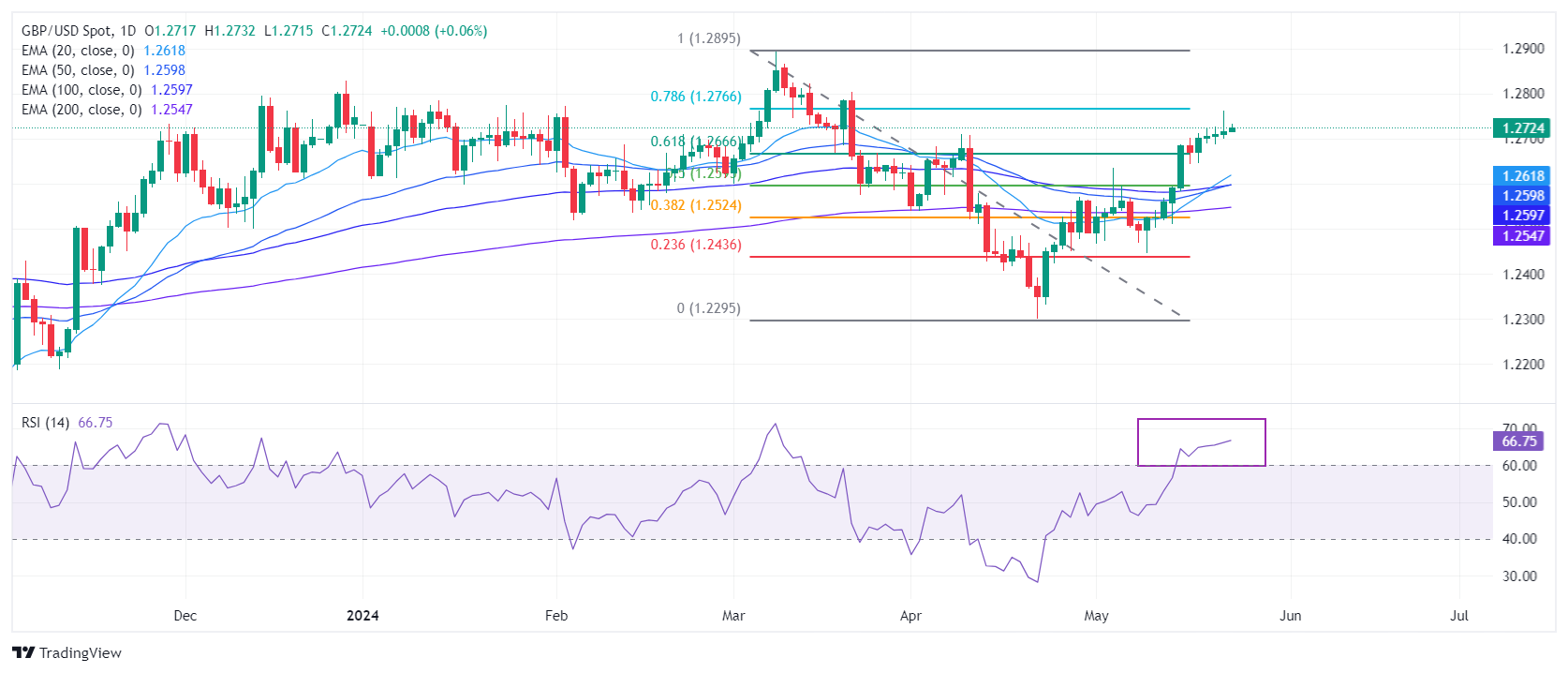Pound Sterling steadies above 1.2700 after weak preliminary UK PMI report

- The Pound Sterling faces selling pressure near 1.2750 on weak UK preliminary PMI data for May.
- A slower-than-expected decline in the UK inflation weakens the BoE rate-cut case for June.
- The US Dollar stays firm as the Fed emphasize wait and watch approach on interest rates.
The Pound Sterling (GBP) holds strength above 1.2700 in Thursday’s London session after the release of the weak preliminary United Kingdom (UK) PMI data for May. The S&P Global/CIPS PMI report shows that the Composite PMI dropped at a faster pace to a two-month low at 52.8 from the estimates of 54.0 and the prior reading of 54.1. The sharp decline in the Composite PMI was driven by weak Services PMI, which fell to a six-month low at 52.9 from the consensus of 54.7 and the former reading of 55.0. The Manufacturing PMI rose above the 50.0 threshold that separates expansion from contraction and grew strongly to 51.3. Economists forecasted that the factory PMI would have increased to 49.5 from 49.1 in April.
The GBP/USD pair remains firm as traders pare bets that were leaned towards the Bank of England (BoE) shifting to policy normalization in the June meeting after remaining hawkish for more than two years on interest rates. The expectations favoring the BoE that it will start reducing interest rates from the June meeting have diminished as the Consumer Price Index (CPI) report for April showed that inflation softened at a slower pace than expected.
According to the CPI report, annual headline and core inflation declined to 2.3% and 3.9%, respectively. The inflation measure that dashed hopes of BoE rate cuts in June is the service price index, which declined modestly to 5.9% from the prior reading of 6.0%. UK’s stubborn service inflation has remained a major barrier in the progress of disinflation, which is driven by wage growth.
Daily digest market movers: Pound Sterling remains firm as US Dollar drops
- The Pound Sterling exhibits strength against the US Dollar as investors expect that rate cuts from the BoE will be delayed due to slower than-expected decline in the UK inflation for April. Before the June meeting, the BoE will be having one more employment and inflation data, which could strengthen the case of rate cut if comes in-line with central bank’s forecasts.
- Sterling is expected to remain in action on Friday, too, as the UK Office for National Statistics (ONS) will report the Retail Sales data for April. The Retail Sales data represents household spending, which provides significant cues about the inflation outlook. On a month-on-month basis, Retail Sales are estimated to have declined by 0.4% after remaining stagnant last month. Annually, Retail Sales are expected to have contracted by 0.2% against a growth of 0.8% in March.
- On the other side of the Atlantic, the US Dollar fails to hold gains, which were induced by fears that progress in the United States inflation declining towards the 2% target has stalled. The Federal Open Market Committee (FOMC) minutes for the May meeting, released on Wednesday, suggested that the confidence needed for them to consider rate cuts has been dented due to disappointment from recent inflation data.
- Going forward, investors will focus on the preliminary S&P Global PMI for May and the Initial Jobless Claims data for the week ending May 17. For last two weeks, number of individuals claiming jobless benefits have remained more than expected, which have indicated that the labor market strength is easing.
Technical Analysis: Pound Sterling continues winning spell
The Pound Sterling extends its winning spell for the fifth trading session on Thursday due to weak UK Services PMI data for May. Though, the GBP/USD pair is still comfortably stabilized above the 61.8% Fibonacci retracement (plotted from the March 8 high of 1.2900 to the April 22 low at 1.2300) at 1.2667.
The Cable is expected to remain in the bullish trajectory as all short-to-long-term Exponential Moving Averages (EMAs) are sloping higher, suggesting a strong uptrend.
The 14-period Relative Strength Index (RSI) has shifted into the bullish range of 60.00-80.00, suggesting that the momentum has leaned toward the upside.
